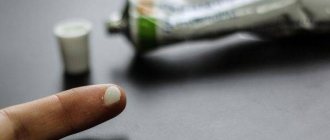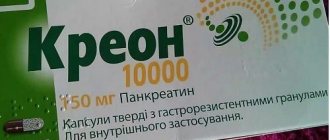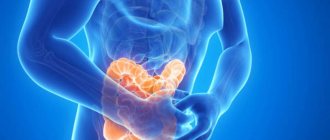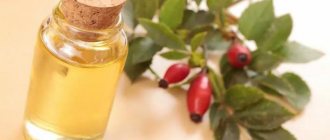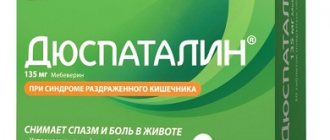Release form and composition
You can buy Iberogast at the pharmacy in bottles of 20 ml, 50 ml and 100 ml. The analyzed drug is produced in the form of a tincture. 100 ml of the drug contains alcohol extracts of the following components:
- 15 ml of freshly picked bitter iberis;
- 10 ml of angelica roots, cumin, milk thistle, lemon balm leaves, celandine and licorice roots;
- 20 ml chamomile petals;
- 5 ml peppermint leaves.
Additional elements include ethanol, the total content of which from the entire mass of the drug is 31%.
Components of the drug
The product contains exclusively medicinal plants. That is why doctors classify the drug “Iberogast” not as a medicinal method of dealing with problems, but as herbal medicine. The composition includes the following medicinal herbs:
- chamomile flowers;
- mint and lemon balm leaves;
- celandine grass;
- licorice and angelica root;
- bitter iberis (root);
- caraway fruits.
In addition, the tincture is alcoholic. The composition includes 31% ethanol, which allows you to preserve all the beneficial properties of herbs and plants.
Pharmacological action of Iberogast
The instructions for Iberogast indicate that the main effect of this drug is aimed at eliminating inflammatory processes in the stomach. In addition, the drug normalizes the tone of the smooth muscles of the entire digestive system: it perfectly eliminates spasms without affecting the normal contraction of the walls of the gastrointestinal tract. If decreased tone or motor skills are observed, Iberogast acts as a stimulant, restoring normal muscle tone. Reviews of Iberogast also say that this drug reduces the force of ulceration of the gastric mucosa and the secretion of hydrochloric acid, reduces the amount of leukotrienes, increases the production of mucins and the content of mucoprotective prostaglandin E2 in the gastric mucosa.
How the drug works
If a doctor has recommended Iberogast for use, the use and method of action on the body should be studied in advance. These include:
- Relieving abdominal pain, cramps, heaviness.
- Elimination of flatulence in the stomach and intestines.
- Relief from bloating.
- Normalization of intestinal microflora (colonization with beneficial bacteria).
- Elimination of pathogenic bacteria (including those belonging to the Helicobacter pylori category).
- Normalization of gastric juice acidity.
- Healing of small wounds and ulcers on the walls of the stomach and intestines.
- Normalizing intestinal smooth muscles.
- Elimination of heartburn.
It is noteworthy that regular use of the drug allows you to normalize intestinal function, which means that such a concept as constipation will remain only a memory. In addition, Iberogast, analogues of which are given below, is often used as one of the means in the complex treatment of duodenal and gastric ulcers, and the prevention of liver and kidney diseases. The drug is produced in the form of drops, in a dark bottle with a tight-fitting cap. The shelf life of the product is 2 years. After this time, taking the product is categorically not recommended, and even moreover, it is dangerous to health.
Indications for use of Iberogast
Iberogast, according to the instructions, is prescribed in the following cases:
- To eliminate functional disorders of the digestive system, as well as irritable bowel syndrome. Such diseases are manifested by symptoms such as nausea, intestinal or stomach spasms, belching, heaviness in the epigastric region, constipation or diarrhea, and flatulence.
- As an auxiliary drug for the preventive treatment of diseases of the duodenum, during gastritis and stomach ulcers.
For patients with liver disease, Iberogast is prescribed with caution, since the drug contains ethanol.
Taking Iberogast while pregnant or breastfeeding
The drug contains herbal components, which include extracts of Iberian bitters, medicinal angelica, chamomile, common cumin, spotted milk thistle, medicinal lemon balm, peppermint, May celandine, and licorice. The extracting agent (auxiliary substance) is a 31% alcohol solution. Due to the absence of chemically synthesized components and plant origin of active ingredients, the medication is considered relatively safe for the body of a developing fetus or infant. The official instructions indicate that the use of Iberogast during breastfeeding and pregnancy is allowed after prescription by a gynecologist. The specialist determines the presence of medical indications and also assesses possible risks.
Indications for taking the drug during pregnancy and lactation
There are several medical indications for prescribing medication during pregnancy and lactation (breastfeeding or breastfeeding):
- Dyspepsia, which has a functional origin and is accompanied by bloating, unstable stools, nausea with periodic vomiting.
- Violation of intestinal motility (wave-like movements of the walls aimed at pushing the contents into the lower parts of the gastrointestinal tract).
- Irritable bowel syndrome (IBS), which is a functional disorder.
- Peptic ulcer with localization of changes in the mucous membrane in the stomach or duodenum (the drug is prescribed as part of complex therapy).
- Stomach cramps of various origins (local increase in the tone of the smooth muscles of the walls of the hollow structures of the digestive system).
- Flatulence (bloating) due to functional disorders, somatic or infectious diseases.
- Heartburn, frequent belching.
Identification of medical indications for the use of a medicinal product should be carried out in conjunction with a doctor.
Absolute contraindications to the use of Iberogast in expectant and nursing mothers
There are several absolute contraindications, the presence of which excludes the prescription of the medication:
- Individual intolerance to any of the components.
- Calculous cholecystitis is an inflammation of the gallbladder, accompanied by the formation of insoluble calculi (stones) in its cavity.
- Children and adolescents under 18 years of age, since there is no reliable data on the safety of the medication.
The drug can be used with caution in case of concomitant pathology of the liver, brain, as well as after traumatic brain injury.
special instructions
The preparation contains ethyl alcohol, the amount of which in the entire bottle does not exceed 33%. Taking 20 drops of the product (1 dose) once, the patient receives up to 0.24 g of absolute ethyl alcohol. Using the maximum permissible daily dose, the patient receives up to 0.72 g of absolute ethyl alcohol.
When storing Iberogast, cases of clouding of the contents of the bottle or the formation of a small sediment in it are sometimes observed. This does not in any way affect the quality of the components of the drug.
Reviews of Iberogast indicate that before using the product, the bottle must be shaken well.
While taking this drug, it is not recommended to drive a car or operate other mechanisms, which require increased attention if the daily dose of Iberogast has been increased for any reason.
Analogs
The composition of such drugs does not exist. However, there are those that are similar to Iberogast in action. The price category, by the way, is approximately the same for everyone. Although the composition may differ significantly or, conversely, slightly from the drug Iberogast.
The analogue that is most famous today is “Hilak Forte”. Its main task is to normalize the intestinal microflora, which for some reason has been significantly disrupted. For example, while taking antibiotics. And yet, the spectrum of effects on the body is not as wide as that of the drug Iberogast.
An analogue that is similar in pharmacological properties is Enterol. Its main feature is its antimicrobial effect on the intestines and stomach. Similar means include the following:
- "Pikolaks";
- "Bifidumbacterin";
- "Linex";
- "Almagel";
- "Smecta".
But unfortunately, they do not have complex properties. Most often, they are intended to populate the intestines and stomach with beneficial bacteria, but they do not solve all problems. Thus, Almagel has too many contraindications and side effects. Still, other manufacturers have not been able to completely replicate a drug like Iberogast.
Iberogast and treatment of gastritis
Almost half of the adult population of our country and all of Europe suffer from gastritis. After such a diagnosis is made, treatment is carried out in a complex, based on the individual characteristics of the body. The herbal remedy Iberogast occupies a leading position in the effective treatment of gastritis.
The right combination and ratio of plants in this remedy helps to have a comprehensive effect on the organs of the gastrointestinal tract, which helps cure gastritis. Iberogast has been successfully used by gastroenterologists in Europe for half a century. During this time, this drug was able to establish itself as one of the most effective.
How does Iberogast work on gastritis?
Atrophic gastritis is an insidious disease. It does not always cause any pain or noticeable discomfort, and people usually do not understand the danger of metabolic disorders that develop due to the death of normal stomach cells.
So gradually, if atrophic gastritis is not treated, this pathology without pronounced symptoms turns into cancer. But all that can help is taking two or three medications and following a diet for a long time.
Types of treatment
For atrophic gastritis, only conservative treatment is carried out:
- it makes no sense to remove anything, since areas of atrophy are located in larger or smaller foci;
- before the cells degenerate into cancer, they can (and should) be brought back to life;
- Only with the help of conservative methods is it possible, by carefully inducing the gastric mucosa to recover, to supply the food needed to establish metabolism into the further parts of the digestive tract.
The inflammatory process affecting various digestive organs requires an integrated approach to therapy. Herbs for the pancreas in the treatment of pancreatitis are used as an additional technique that can improve the functional state and accelerate the recovery of damaged glandular cells.
Medicinal plants help in the treatment of a large number of diseases. Despite the positive therapeutic effects, they can only be used in combination with other measures.
How treatment directions are used
Regardless of the cause of inflammation, its severity, tissue coverage by the pathological process, comprehensive therapy is always prescribed.
It includes several areas:
- Etiotropic therapy is treatment aimed at eliminating the influence of the main cause that led to the development of the disease.
- Pathogenetic therapy - reducing the inflammatory reaction, improving the functional state of the affected organ, reducing the load on it, normalizing the outflow of pancreatic juice in the ducts.
- Symptomatic therapy often overlaps with pathogenetic treatment and helps reduce the intensity of clinical manifestations of pathology and the severity of unpleasant subjective feelings of discomfort.
Indications
Treatment of inflammation of the pancreas with herbs is indicated as an additional method of complex measures for certain pathological conditions:
- chronic pancreatitis in remission and relapse;
- autoimmune pancreatitis;
- inflammation of alcohol origin;
- pancreatic steatorrhea;
- subacute pancreatitis;
- formation of a cyst (a cavity limited by connective tissue and filled with fluid);
- purulent inflammation;
- formation of an abscess (a limited cavity filled with pus);
- a combined disease, including pathology of other organs, as well as metabolic disorders (diabetes mellitus).
Contraindications
Herbs can be drunk for pancreatitis only if there are no contraindications, which include:
- the presence of individual intolerance to components;
- development of allergic reactions to various organic compounds included in herbs;
- concomitant pathology affecting internal organs, as well as structures of the cardiovascular system;
- metabolic disorders (metabolism), in which taking herbs can lead to aggravation of the pathological condition;
- pancreatic necrosis – tissue death caused by “self-digestion” of the gland by digestive enzymes;
- acute course of the inflammatory reaction.
For pancreatic necrosis, urgent therapeutic measures are usually performed in a medical hospital. In the acute course of a pathological process or against the background of an exacerbation of a chronic disease, the possibility of additional use of plants is determined by the doctor individually.
Impact
Plant-based products contain a significant amount of organic compounds (carbohydrates, alkaloids) that affect cell receptors and affect metabolism.
Take 0.3 cups per day before meals for gastritis with low acidity of gastric juice. Three-leaf watch - 1 tablespoon, marsh myrtle - 1 teaspoon.
Pour a tablespoon of the mixture into a glass of boiling water, leave for 30 minutes and strain. For gastritis, take 1 teaspoon 3 times a day 30 minutes before meals with a sip of water.
Eliminates sadness in the esophagus within 3 days after taking it. Conflict half a glass 3 - 4 gastritis per day. Apply one palm of sunflower three times a day before meals to treat ailments with low acidity of whey juice.
Gastric drops 25 ml. With a diseased kidney in the stomach, the toxic collection increases:.
Digestive disorders are one of the most pressing issues in medicine today. This is due to many factors: a violation of the nutritional culture, a decrease in the quality of food products, the popularization of fast food and semi-finished products, bad habits and everyday stressful situations.
One of the most common diagnoses in gastroenterology today is chronic gastritis, which affects almost half of the adult population.
Once the diagnosis is established, comprehensive, individually tailored treatment is carried out. The combined herbal preparation Iberogast occupies a special place in the treatment of gastritis.
Substances of plant origin have been used to treat gastrointestinal problems since ancient times. Currently, the emergence of complex herbal medicines in the arsenal of gastroenterologists makes it possible to use the medicinal potential of plants more effectively.
The correct combination and ratio of plant substances in the preparation plays an important role, which contributes to the most comprehensive effect in the treatment of gastritis. Iberogast is by far the most effective and balanced remedy in this group.
It has been successfully used by gastroenterologists in European countries for 50 years, and has proven itself well in the practice of domestic specialists.
Iberogast acts gently for gastritis, without causing side effects, and provides a good clinical effect, proven by numerous placebo-controlled studies. The drug is safe for use in all categories of the population, including children and the elderly, and is not contraindicated during pregnancy.
In many cases where there are contraindications to standard drug therapy for gastritis, Iberogast is the drug of choice. Despite the safety of using the drug, if you suspect gastritis or other pathology of the gastrointestinal tract, you need to contact your doctor to make an accurate clinical diagnosis and prescribe individually selected treatment.
Price
The cost of one bottle, the volume of which is 20 ml, varies between 300-350 rubles. In this case, the drug will only last for a couple of weeks. Those who are prescribed long-term use should pay attention to bottles of 50 or 100 ml. Their cost varies between 500-650 rubles. Iberogast, whose price is not so affordable, is not exactly a drug in the classical sense. It is rather a homeopathic, phytotherapeutic remedy that really benefits the body without having virtually any side effects. It is worth noting that analogues of the drug cost approximately the same. With rare exceptions. So, “Smecta” may cost a little less, but the effect of the product is completely different - getting rid of nausea, diarrhea, vomiting, and normalizing stool.
Will Smecta help with heartburn?
Even such a seemingly insignificant pathology as heartburn should be treated under the supervision of a specialist. Each case of heartburn is individual and the dosage of the drug is selected only by a doctor. In addition, treating heartburn with Smecta may not be enough. This drug does not have a therapeutic effect against heartburn.
The action of the drug is aimed at restoring the mucous membrane after the aggressive effects of hydrochloric acid.
However, the action of Smecta can alleviate the condition of a pregnant patient. For example, after heartburn occurs once, this drug will eliminate the consequences and slightly smooth out the burning sensation. It is important to understand that the causes of heartburn in the early stages are different from the causes in the third trimester.
Fetal hypoxia and 3 methods for determining it
To eliminate discomfort in the esophagus and stomach, you must carefully study the instructions:
- Dissolve according to the instructions and drink three sachets per day for adults, but after the same amount of time.
- From 1 to 2 years, one sachet dissolves, but the essence of administration is the same as for adults.
- For children over 2 years old, two sachets are taken.
It is important to monitor your condition; if no improvement occurs, it is recommended to stop taking it and see a doctor.
Smecta contraindications
There are few contraindications for this drug, but it is important to study the instructions and exclude the possibility of a negative effect from taking the medication.
Causes of dizziness during pregnancy
Contraindications:
- Intestinal obstruction. Disruption of the intestines as a result of blockage with feces. This condition is dangerous due to tissue necrosis, as well as peritonitis of the abdominal wall. Smecta causes constipation, which increases the chance of obstruction. Even if there is a small chance of intestinal problems, Smecta should not be taken.
- If a pregnant woman suffers from fructose intolerance or glucose and lactose malabsorption syndrome, then Smecta is not prescribed. Since Smecta contains simple sugars, the breakdown of which is impossible in case of fructose intolerance, the use of Smecta can be harmful. When fructose and sucrose enter the body, patients experience symptoms of hypoglycemia or a decrease in blood glucose concentration. Patients with hypoglycemia may experience sweating, weakness, cramps, nausea and vomiting, and body tremors when consuming Smecta. With a long course of treatment, the kidneys, liver and brain are affected.
- In case of individual intolerance to some components of the drug. Each person individually exhibits increased sensitivity to certain components. The body reacts with allergies or other symptoms to a substance that is not suitable for the body. Allergies are primarily angioedema, anaphylactic shock and others. However, often special sensitivity manifests itself individually. The risk of severe reactions with subsequent complications is very high, so taking this medicine is not recommended for all pregnant women.
You can replace Smecta with Enterosgel, Enterodes, Maalox, Activated carbon, etc., the principle of action of all drugs is largely similar.
Description of the dosage form
Dark brown liquid from clear to slightly cloudy. During storage, minor sediment may form.
Interaction with other drugs is currently unknown.
The possibility of interaction with drugs whose metabolism is carried out with the participation of CYP450 should be taken into account (licorice roots, milk thistle fruits, chamomile flowers can have an inhibitory effect on a number of CYP450 isoenzymes). Moreover, these effects were dose-dependent in nature and were observed when individual components were used in concentrations many times higher than the recommended daily doses of Iberogast®.
Interaction with other drugs is currently unknown.
The possibility of interaction with drugs whose metabolism is carried out with the participation of the cytochrome P450 system should be taken into account (licorice roots, milk thistle fruits, chamomile flowers can have an inhibitory effect on a number of cytochrome P450 isoenzymes). Moreover, these effects are dose-dependent in nature and are described when using individual components in concentrations many times higher than the recommended doses of the drug.
The interaction of this drug with other drugs has not been noted.




